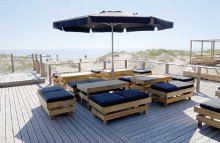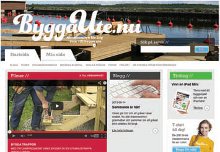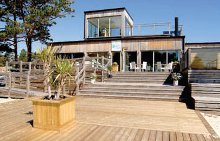Suitable case for online treatment
29 June 2013The multiple benefits of treated timber need to be more widely promoted and the internet is the ideal communication vehicle, reports Mikael Westin of the Swedish Wood Preserving Association.
The internet is shaping the way we do business and what we consume and that must apply to treated timber as much as any other sector or product. Consequently, at the Swedish Wood Preserving Association (SWPA) we're putting a much stronger focus on using the web to educate the market about its performance and benefits and to drive consumption. Having been a rather traditional industry association earlier, we now feel quite modern!
Our latest development is our new consumer website. We've called it www.byggaute.nu, which translates as buildingoutside.now. The aim is to inspire DIYers to undertake projects using treated timber and to help and encourage them by showing simple solutions.
The site links to web-based building instructions and informative videos on projects including building a deck, staircase or balustrade, created by the Swedish Forest Industries Federation (Skogsindustrierna) and its promotional arm, Swedish Wood. It also contains an interactive forum for users to post questions and an expert and guest blog section. As well as treatment and building experts, so far, we've had an artist and a professor as bloggers!
For inspiration, we're building up an online gallery of beautiful decking applications and have now been given permission to include pictures from the UK Timber Decking and Cladding Association (TDCA), with which we already work closely on technical and market issues. Maybe traditional British and Nordic deck approaches and aesthetics differ, but sharing new design ideas between markets may be just the spur consumers need to go ahead on a project.
We also invite DIYers to send in pictures of their own projects for us to post on the site.
It was actually our increasingly close links with the TDCA that led to our new, stronger focus on the web. The organisation is doing a great job to stimulate deck building, using the internet as a key tool. But it's been a two-way ideas exchange. We're also sharing our Bygge Ute! smartphone app with them, which we introduced in Sweden last year. It features a decking calculator to help you work out the timber dimensions and components you need.
The TDCA is also heavily involved in maintaining industry standards through the DeckMark and CladMark quality assurance schemes - which it also promotes online. This is another common link for us, as we are among the lead supporters of the Nordic-wide NTR system (www.ntr-nwpc.com) for assuring and maintaining quality, also highlighted on www.byggaute.nu. It is important for the treated timber industry to realise that quality is essential to its future. Consumers have a right to expect that the deck or other outdoor structure in which they've invested time and money will last 20-40 years or more, if correctly built. And we must have the confidence to promote that sort of durability to the market. Any product deficiencies that reduce resistance to biological deterioration will damage not only the treated wood sector, but wood as a whole.
Nordic countries don't generally use treated spruce, especially not in ground contact. But we've recently introduced a NTR-class treated spruce, NTR Gran, for exterior cladding, bargeboards, weatherboards and battens, rather than decking. We want to introduce this to the UK market and are considering promotional activity for architects.
Another concern at the SWPA is that a lot of valuable scientific reports making the case for our industry and products are left unused and unexploited, in terms of communicating their findings to a wider interested audience. One example is a study on waste issues. In Sweden and other countries treated timber is classified as hazardous but it doesn't have to be.
According to a report from the Swedish Environmental Research Institute, waste from timber treated with latest copper-based preservatives should not fall into the hazardous category. Convincing authorities and waste handling agencies of this could make a huge difference for our members and builders merchants. So to communicate the results of this and other study findings, we're considering creating an easily understood manual or booklet, and possibly an app, to give the latest technical facts.
The SWPA is also supporting a very worthwhile project with the Royal Institute of Technology (KTH) in Stockholm. A group of KTH students are working on a task to build a school in the Congo region in a mission led by the Swedish International Development Co-operation Agency. The objective is to devise a simple, easy-to-assemble framework construction. The walls will comprise local material, with the students responsible for logistics and designing the special metal connectors. The SWPA will supply all the treated timber, giving us another good story to tell online.




